Suchergebnisse für "mega 2560"
-

Arduino Arduino Mega 2560 Rev3
Es enthält alles, was Sie zum Betrieb des Mikrocontrollers benötigen. Schließen Sie es einfach mit einem USB-Kabel am Computer an oder speisen Sie es mit einem AC/DC-Adapter oder einer Batterie, um loszulegen. Das Mega 2560 Board ist kompatibel mit den meisten Shields, die für den Uno und die früheren Boards Duemilanove oder Diecimila entwickelt wurden. Betriebsspannung 5 V Eingangsspannung 7 V - 12 V Digitaler E/A 54 Analoge Eingangs-Pins 16 Gleichstrom pro I/O-Pin 20 mA Gleichstrom für 3,3-V-Pin 50 mA Flash-Speicher 256 KB davon 8 KB vom Bootloader genutzt SRAM 8 KB EEPROM 4 KB Taktfrequenz 16MHz LED_Builtin 13 Länge 101.52 mm Breite 53.3 mm Gewicht 37 g Weitere Informationen finden Sie in der Getting Started Guide von Arduino.
€ 44,95
Mitglieder € 40,46
-

JOY-iT JOY-iT Mega 2560 Pro
Dieses JOY-iT Mikrocontrollerboard eröffnet Ihnen die Welt des Programmierens und bietet ihnen die gleiche Rechenleistung des Meganbsp;2560, aber mit einer geringeren Fläche (Footprint). Es hat zudem viel mehr Anschlüsse als vergleichbare Boards (Arduino Uno). Er wird mit der Arduino-IDE betrieben und die Stromversorgung kann entweder über den USB-Anschluss oder die VIN-Pins erfolgen. Das ermöglicht Ihnen eine sichere Nutzung mit vielen anderen Geräten (z. B. Desktop-PC). Daher ist der Mega 2560nbsp;Pro hochintegrierbar. Features Microcontroller ATmega2560 - 16AU Speicherplatz Flash 256 KB, SRAM 8 KB, EEPRom 4 KB Pinanzahl:Digital I/OPWM OutputAnalog Input 541516 Kompatibel mit Arduino, Desktop PCs, etc. Besonderheiten USB-Port oder Power Pins zur Stromversorgung Anschlusswandler MicroUSB zu USB-UART Abmessungen 55 x 38 mm Lieferumfang JOY-iT Mega 2560 Pro mit Pins Weitere Spezifikationen Eingangspannung 7 - 9 Volt über Vin, 5 Volt über mUSB Logik Level 5 Volt Ausgangsspannung 800 mA Sapnnungsregulator LDO (bis zu 12 Voltspitzen) Frequenz 16 MHz (zum Datenaustausch sind 12 MHz möglich) Downloads Handbuch
€ 29,95
Mitglieder € 26,96
-

Elektor Digital Ultimate Arduino Mega 2560 Hardware Manual (E-book)
A Reference and User Guide for the Arduino Mega 2560 Hardware and Firmware A manual providing up-to-date hardware information for the Arduino Mega 2560. The Arduino Mega 2560 is an upgrade to the popular Arduino Uno board, providing more pins, serial ports and memory. Arduino is the easy to use open-source electronics platform used by hobbyists, makers, hackers, experimenters, educators and professionals. Get all the information that you need on the hardware and firmware found on Arduino Mega 2560 boards in this handy reference and user guide. Ideal for the workbench or desktop. This manual covers the Arduino Mega 2560 hardware and firmware, and is a companion volume to the Ultimate Arduino Uno Hardware Manual, which covers the Arduino Uno hardware and firmware. Contains all of the Arduino Mega 2560 hardware information in one place Covers Arduino / Genuino Mega 2560 revision 3 and earlier boards Easily find hardware technical specifications with explanations Pin reference chapter with interfacing examples Diagrams and illustrations for easy reference to pin functions and hardware connections Learn to back up and restore firmware on the board, or load new firmware Basic fault finding and repair procedures for Arduino Mega 2560 boards Power supply circuits simplified and explained Mechanical dimensions split into five easy to reference diagrams Contains circuit diagrams, parts list and board layout to easily locate components A chapter on shield compatibility explains how shields work across different Arduino boards
€ 32,95
Mitglieder € 26,36
-

Elektor Publishing C Programming with Arduino
Technology is constantly changing. New microcontrollers become available every year. The one thing that has stayed the same is the C programming language used to program these microcontrollers. If you would like to learn this standard language to program microcontrollers, then this book is for you! Arduino is the hardware platform used to teach the C programming language as Arduino boards are available worldwide and contain the popular AVR microcontrollers from Atmel. Atmel Studio is used as the development environment for writing C programs for AVR microcontrollers. It is a full-featured integrated development environment (IDE) that uses the GCC C software tools for AVR microcontrollers and is free to download. At a glance: Start learning to program from the very first chapter No programming experience is necessary Learn by doing – type and run the example programs A fun way to learn the C programming language Ideal for electronic hobbyists, students and engineers wanting to learn the C programming language in an embedded environment on AVR microcontrollers Use the free full-featured Atmel Studio IDE software for Windows Write C programs for 8-bit AVR microcontrollers as found on the Arduino Uno and MEGA boards Example code runs on Arduino Uno and Arduino MEGA 2560 boards and can be adapted to run on other AVR microcontrollers or boards Use the AVR Dragon programmer/debugger in conjunction with Atmel Studio to debug C programs
€ 49,95
Mitglieder € 44,96
-

Elektor Digital Mastering Microcontrollers Helped by Arduino (3rd Edition) | E-book
Dritte, erweiterte und überarbeitete Auflage mit AVR Playground und Elektor Uno R4 Arduino-Boards erfreuen sich großer Beliebtheit. Sie sind einfach zu bedienen und kostengünstig. Dieses Buch macht Sie nicht nur mit der Welt von Arduino vertraut, sondern bringt Ihnen auch die Programmierung von Mikrocontrollern im Allgemeinen bei. In diesem Buch wird die Theorie auf einem Arduino-Board mithilfe der Arduino-Programmierumgebung in die Praxis umgesetzt. Es wurde auch einige Hardware entwickelt: ein Mehrzweck-Shield zum Erstellen einiger der Experimente ab den ersten 10 Kapiteln; der AVR Playground, ein echtes Arduino-basiertes Mikrocontroller-Entwicklungsboard für die komfortable Anwendungsentwicklung, und der Elektor Uno R4, ein Arduino Uno R3 auf Steroiden. Der Autor, ein Elektor-Experte, vermittelt dem Leser die grundlegenden theoretischen Kenntnisse, die zum Programmieren eines beliebigen Mikrocontrollers erforderlich sind: Ein- und Ausgänge (analog und digital), Interrupts, Kommunikationsbusse (RS-232, SPI, I²C, 1-Wire, SMBus usw.), Timer und vieles mehr. Die im Buch vorgestellten Programme und Skizzen zeigen, wie verschiedene gängige elektronische Komponenten verwendet werden: Matrixtastaturen, Displays (LED, alphanumerische und grafische Farb-LCDs), Motoren, Sensoren (Temperatur, Druck, Feuchtigkeit, Ton, Licht und Infrarot), Drehgeber, Piezo-Summer, Drucktasten, Relais usw. Dieses Buch wird Ihr erstes Buch über Mikrocontroller mit einem Happy End sein! Dieses Buch ist für Sie, wenn Sie ein Anfänger in Sachen Mikrocontroller sind, ein Arduino-Benutzer (Bastler, Tüftler, Künstler usw.), der sein Wissen vertiefen möchte, ein Student der Elektronik im Grundstudium oder ein Lehrer auf der Suche nach Ideen. Dank Arduino ist die Umsetzung der vorgestellten Konzepte einfach und macht Spaß. Einige der vorgeschlagenen Projekte sind sehr originell: Geldspiel Misophon (eine musikalische Gabel) Auto-GPS-Scrambler Wetterstation DCF77 Decoder Illegaler Zeitsender Infrarot-Fernbedienungsmanipulator Störender Geräuschgenerator Italienischer Hupenalarm Überhitzungsdetektor PID-Regler Datenlogger SVG-Datei Oszilloskop 6-Kanal Voltmeter Alle Projekte und Codebeispiele in diesem Buch wurden auf einem Arduino Uno-Board erprobt und getestet. Sie sollten auch mit dem Arduino Mega und jedem anderen kompatiblen Board funktionieren, das über die Erweiterungsanschlüsse des Arduino Shield verfügt. Datenblätter Verwendete aktive Komponenten (PDF-Datei): ATmega328 (Arduino Uno) ATmega2560 (Arduino Mega 2560) BC547 (Bipolartransistor, Kapitel 7, 8, 9) BD139 (bipolarer Leistungstransistor, Kapitel 10) BS170 (N-MOS-Transistor, Kapitel 8) DCF77 (Empfangsmodul, Kapitel 9) DS18B20 (Temperatursensor, Kapitel 10) DS18S20 (Temperatursensor, Kapitel 10) HP03S (Drucksensor, Kapitel 8) IRF630 (N-MOS-Leistungstransistor, Kapitel 7) IRF9630 (P-MOS-Leistungstransistor, Kapitel 7) LMC6464 (Vierfach-Operationsverstärker, Kapitel 7) MLX90614 (Infrarotsensor, Kapitel 10) SHT11 (Feuchtigkeitssensor, Kapitel 8) TS922 (Doppel-Operationsverstärker, Kapitel 9) TSOP34836 (Infrarot-Empfänger, Kapitel 9) TSOP1736 (Infrarot-Empfänger, Kapitel 9) MPX4115 (analoger Drucksensor, Kapitel 11) MCCOG21605B6W-SPTLYI (I²C LCD, Kapitel 12) SST25VF016B (SPI EEPROM, Kapitel 13) Über den Autor: Clemens Valens, geboren in den Niederlanden, lebt seit 1997 in Frankreich. Er ist Manager bei Elektor Labs und Webmaster von ElektorLabs. Er liebt die Elektronik und entwickelt zum Spaß Mikrocontrollersysteme, manchmal aber auch für seinen Arbeitgeber. Clemens ist ein Polyglott – er spricht fließend C, C++, PASCAL, BASIC und mehrere Assemblerdialekte – und verbringt die meiste Zeit an seinem Computer, während seine Frau, ihre zwei Kinder und zwei Katzen versuchen, seine Aufmerksamkeit zu erregen (nur die Katzen haben Erfolg). Besuchen Sie die Website des Autors: www.polyvalens.com . Authentisches Zeugnis von Hervé M., einem der ersten Leser des Buches: „Ich hätte fast vor Freude geweint, als mir dieses Buch in nur drei Sätzen Dinge verständlich machte, die mir vorher völlig unverständlich schienen.“
€ 34,95
Mitglieder € 27,96
-

Elektor Publishing Mastering Microcontrollers Helped by Arduino (3rd Edition)
Third, extended and revised edition with AVR Playground and Elektor Uno R4 Arduino boards have become hugely successful. They are simple to use and inexpensive. This book will not only familiarize you with the world of Arduino but it will also teach you how to program microcontrollers in general. In this book theory is put into practice on an Arduino board using the Arduino programming environment. Some hardware is developed too: a multi-purpose shield to build some of the experiments from the first 10 chapters on; the AVR Playground, a real Arduino-based microcontroller development board for comfortable application development, and the Elektor Uno R4, an Arduino Uno R3 on steroids. The author, an Elektor Expert, provides the reader with the basic theoretical knowledge necessary to program any microcontroller: inputs and outputs (analog and digital), interrupts, communication busses (RS-232, SPI, I²C, 1-wire, SMBus, etc.), timers, and much more. The programs and sketches presented in the book show how to use various common electronic components: matrix keyboards, displays (LED, alphanumeric and graphic color LCD), motors, sensors (temperature, pressure, humidity, sound, light, and infrared), rotary encoders, piezo buzzers, pushbuttons, relays, etc. This book will be your first book about microcontrollers with a happy ending! This book is for you if you are a beginner in microcontrollers, an Arduino user (hobbyist, tinkerer, artist, etc.) wishing to deepen your knowledge,an Electronics Graduate under Undergraduate student or a teacher looking for ideas. Thanks to Arduino the implementation of the presented concepts is simple and fun. Some of the proposed projects are very original: Money Game Misophone (a musical fork) Car GPS Scrambler Weather Station DCF77 Decoder Illegal Time Transmitter Infrared Remote Manipulator Annoying Sound Generator Italian Horn Alarm Overheating Detector PID Controller Data Logger SVG File Oscilloscope 6-Channel Voltmeter All projects and code examples in this book have been tried and tested on an Arduino Uno board. They should also work with the Arduino Mega and every other compatible board that exposes the Arduino shield extension connectors. Please note For this book, the author has designed a versatile printed circuit board that can be stacked on an Arduino board. The assembly can be used not only to try out many of the projects presented in this book but also allows for new exercises that in turn provide the opportunity to discover new techniques. Also available is a kit of parts including the PCB and all components. With this kit you can build most of the circuits described in the book and more. Datasheets Active Components Used (.PDF file): ATmega328 (Arduino Uno) ATmega2560 (Arduino Mega 2560) BC547 (bipolar transistor, chapters 7, 8, 9) BD139 (bipolar power transistor, chapter 10) BS170 (N-MOS transistor, chapter 8) DCF77 (receiver module, chapter 9) DS18B20 (temperature sensor, chapter 10) DS18S20 (temperature sensor, chapter 10) HP03S (pressure sensor, chapter 8) IRF630 (N-MOS power transistor, chapter 7) IRF9630 (P-MOS power transistor, chapter 7) LMC6464 (quad op-amp, chapter 7) MLX90614 (infrared sensor, chapter 10) SHT11 (humidity sensor, chapter 8) TS922 (dual op-amp, chapter 9) TSOP34836 (infrared receiver, chapter 9) TSOP1736 (infrared receiver, chapter 9) MPX4115 (analogue pressure sensor, chapter 11) MCCOG21605B6W-SPTLYI (I²C LCD, chapter 12) SST25VF016B (SPI EEPROM, chapter 13) About the author Clemens Valens, born in the Netherlands, lives in France since 1997. Manager at Elektor Labs and Webmaster of ElektorLabs, in love with electronics, he develops microcontroller systems for fun, and sometimes for his employer too. Polyglot—he is fluent in C, C++, PASCAL, BASIC and several assembler dialects—Clemens spends most of his time on his computer while his wife, their two children and two cats try to attract his attention (only the cats succeed). Visit the author’s website: www.polyvalens.com.Authentic testimony of Hervé M., one of the first readers of the book:'I almost cried with joy when this book made me understand things in only three sentences that seemed previously completely impenetrable.'
€ 49,95
Mitglieder € 44,96
-

Elektor Digital C Programming with Arduino (E-book)
Technology is constantly changing. New microcontrollers become available every year. The one thing that has stayed the same is the C programming language used to program these microcontrollers. If you would like to learn this standard language to program microcontrollers, then this book is for you! Arduino is the hardware platform used to teach the C programming language as Arduino boards are available worldwide and contain the popular AVR microcontrollers from Atmel. Atmel Studio is used as the development environment for writing C programs for AVR microcontrollers. It is a full-featured integrated development environment (IDE) that uses the GCC C software tools for AVR microcontrollers and is free to download. At a glance: Start learning to program from the very first chapter No programming experience is necessary Learn by doing – type and run the example programs A fun way to learn the C programming language Ideal for electronic hobbyists, students and engineers wanting to learn the C programming language in an embedded environment on AVR microcontrollers Use the free full-featured Atmel Studio IDE software for Windows Write C programs for 8-bit AVR microcontrollers as found on the Arduino Uno and MEGA boards Example code runs on Arduino Uno and Arduino MEGA 2560 boards and can be adapted to run on other AVR microcontrollers or boards Use the AVR Dragon programmer/debugger in conjunction with Atmel Studio to debug C programs
€ 39,95
Mitglieder € 31,96
-
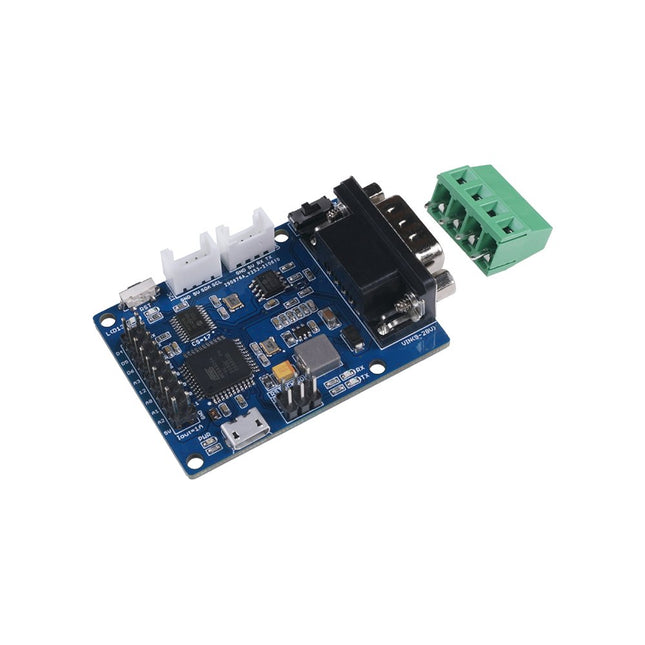
Seeed Studio Seeed Studio CANBed - Arduino CAN-BUS Development Kit (ATmega32U4 with MCP2515 and MCP2551)
Merkmale ATmega32U4 mit Arduino Leonardo Bootloader auf der Platine MCP2515 CAN Bus Controller und MCP2551 CAN Bus Transceiver OBD-II und CAN Standard Pinbelegung am Sub-D Stecker wählbar Kompatibel mit Arduino IDE Parameter Value MCU ATmega32U4 (mit Arduino Leonardo Bootloader) Taktgeschwindigkeit 16 MHz Flash Memory 32 KB SRAM 2.5 KB EEPROM 1 KB Betriebsspannung (CAN-BUS) 9 V - 28 V Betriebsspannung (MicroUSB) 5 V Input Interface sub-D Lieferumfang CANBed PCBA sub-D connector 4PIN Terminal 2 x 4PIN 2.0 Connector 1 x 9x2 2.54 Header 1 x 3x2 2.54 Header
€ 32,95
Mitglieder € 29,66
-
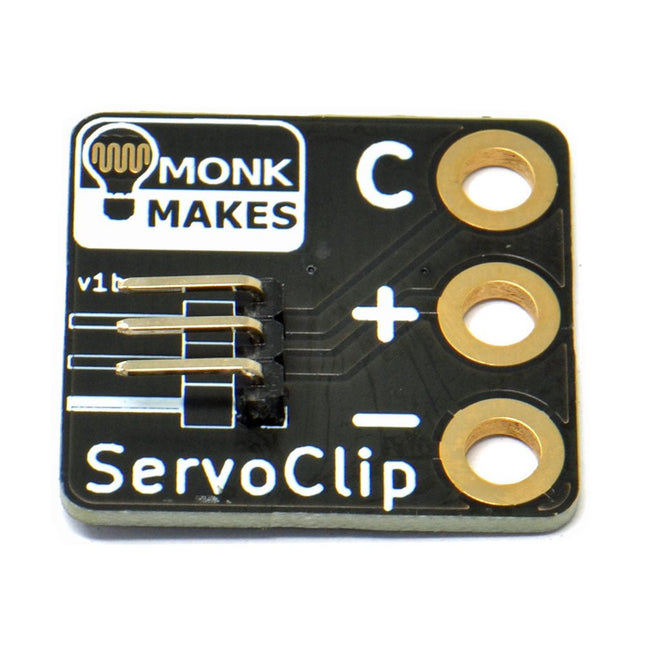
MonkMakes MonkMakes ServoClip
Ein Adapter zum Anschluss eines Servometers mit Krokodil-/Krokodilklemmen. Dies ist eine praktische kleine Klemme zum Anschließen eines Servomotors mit 5,4-mm-Stiftleiste mithilfe von Krokodilklemmen. Es ist ideal für die Verwendung mit Boards wie dem BBC micro:bit und dem Circuit Playground Express oder Gemma von Adafruit. Breite: 27 mm Höhe: 35 mm Downloads Datasheet
€ 3,95
Mitglieder € 3,56
-
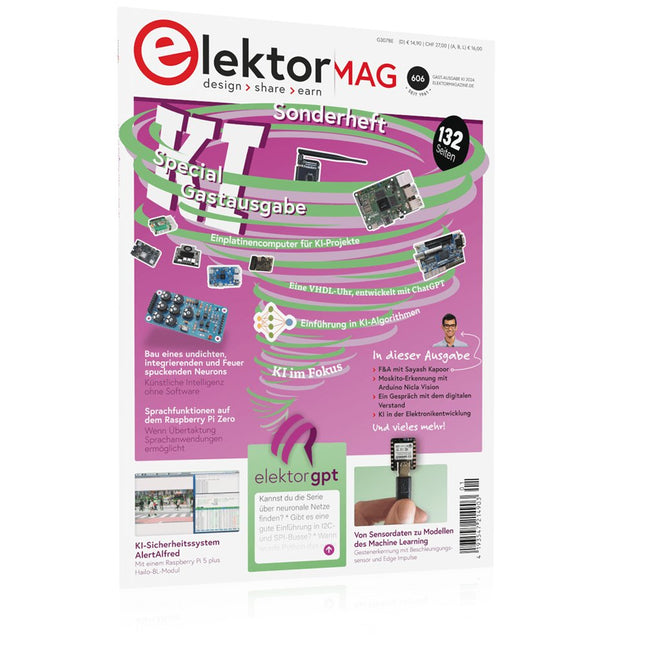
Elektor AI Guest Edition 2024 (DE)
Diese Ausgabe steht allen GOLD- und GREEN-Mitgliedern auf der ElektorMagazine-Website zum Download bereit! Sie sind noch kein Mitglied? Hier klicken! KI-Sicherheitssystem AlertAlfredMit einem Raspberry Pi 5 plus Hailo-8L-Modul KI in der ElektronikentwicklungEin Update nach nur einem Jahr Einführung in KI-AlgorithmenPrompt: Welche Algorithmen werden in KI-Tools verwendet? Einplatinencomputer für KI-ProjekteÜberblick und Hintergründiges Von Sensordaten zu Modellen des Machine LearningGestenerkennung mit einem Beschleunigungssensor und Edge Impulse Bau eines undichten, integrierenden und Feuer spuckenden NeuronsKünstliche Intelligenz ohne Software ChatGPT für den ElektronikentwurfMacht GPT-4o es besser? KI at the Edge mit dem ESP32-P4 Sprachfunktionen auf dem Raspberry Pi ZeroWenn Übertaktung Sprachanwendungen ermöglicht Die wachsende Rolle von Edge-KIEin Trend, der die Zukunft prägt Die Macht der Edge-KI entfesselnEin Gespräch mit François de Rochebouët von STMicroelectronics Eine VHDL-Uhr, entwickelt mit ChatGPT Die wahren Auswirkungen der KISayash Kapoor über „KI-Schlangenöl“ und mehr Das Neueste von BeagleBoardBeagleY-AI, BeagleV-Fire, BeagleMod, BeaglePlay und BeagleConnect Freedom Moskito-Erkennung mit offenen Daten und Arduino Nicla Vision KI heute und morgenEinblicke von Espressif, Arduino und SparkFun Zeitleiste: Künstliche Intelligenz BeagleY-AIDer neuste Einplatinencomputer für KI-Anwendungen KI im FokusPerspektiven aus der Elektor-Community Maschinelles Sehen mit OpenMVBau eines Limonadendosen-Detektors Ein Gespräch mit dem digitalen VerstandChatGPT vs. Gemini Skilling Me Softly with this Bot?Scheitert die KI-Revolution im elektronischen Bereich an mangelnder sozialer Präzision?
€ 14,90
-
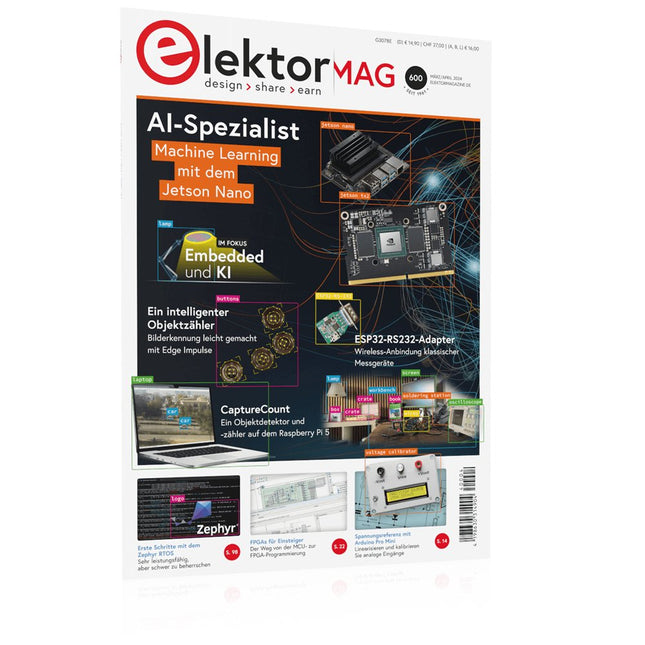
Elektor 03-04/2024
Diese Ausgabe steht allen GOLD- und GREEN-Mitgliedern auf der ElektorMagazine-Website zum Download bereit! Sind Sie noch kein Mitglied? Hier klicken! Anzahl der Erfassungen Ein Objektdetektor und -zähler auf dem Raspberry Pi 5 Spannungsreferenz mit Arduino Pro Mini Linearisieren und kalibrieren Sie analoge Eingänge FPGAs für Einsteiger Der Weg vom Mikrocontroller zur FPGA-Programmierung Update: STM32 Wireless Innovation Design Contest 2024 Bluetooth LE mit MAUI Steuer-Apps für Android und Co. Breakout-Board für Port-Erweiterung Mehr I/Os für Ihr Entwicklungssystem AI-Spezialist Machine Learning mit dem Jetson Nano 2024: Eine Odyssee in die KI Erste Gehversuche mit TensorFlow 262.144 Wege, das Spiel des Lebens zu spielen Ein Leserprojekt in Kürze Aus dem Leben gegriffen Der Chinesische Drache Bringen Sie Ihren DC-Bürstenmotor zum Laufen! Beispielprojekte aus dem Motor Control Development Bundle von Elektor ESP32-RS232-Adapter Wireless-Anbindung klassischer Messgeräte Aller Anfang... ...muss nicht schwer sein: Mehr über Operationsverstärker Empfehlungen für ESP-Bibliotheken Piezoelektrische Bauelemente Bemerkenswerte Bauteile Ein intelligenter Objektzähler Bilderkennung leicht gemacht mit Edge Impulse Meistern Sie die kniffligsten Probleme Ihrer Embedded-Entwicklung! ESP32-Terminal Ein Handheld-Gerät mit Touch-Display Erste Schritte mit dem Zephyr RTOS Sehr leistungsfähig, aber schwer zu. Preisgekrönte Ethik Ein Gespräch mit CTO Alexander Gerfer von Würth Elektronik eiSos über die Ermöglichung von Innovation und achtsames Verhalten Projekt 2.0 Korrekturen, Updates und Leserbriefe
€ 14,90
-
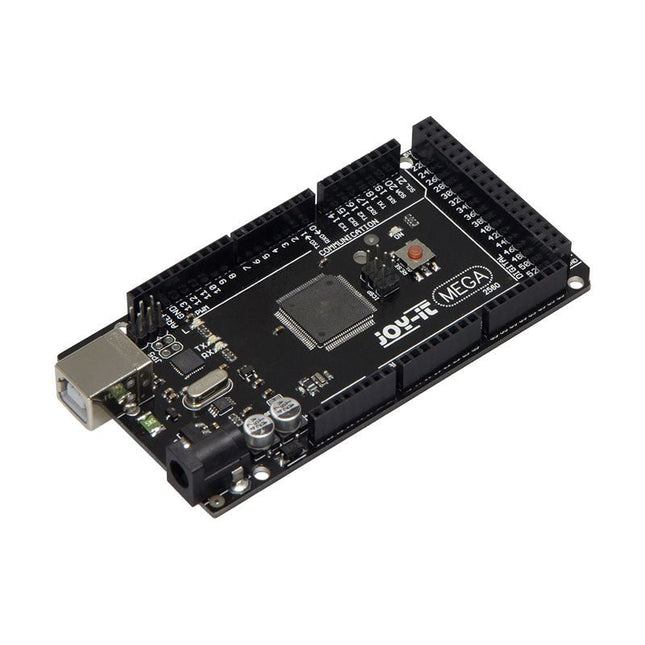
JOY-iT JOY-iT Mega 2560 R3
Wenn Sie schnell und einfach in die Welt der Programmierung einsteigen wollen, ist JOY-iT Mega 2560 R3 das richtige Board für Sie. Dank den zahlreichen Tutorials und Anleitungen für diesen Mikrocontroller können Sie ohne Komplikationen mit der Programmierung beginnen. Der ATmega2560 bietet mit seinen 54 digitalen Ein- und Ausgängen und 16 analogen Eingängen genügend Leistung für Ihre Projekte und Ideen.Um mit der Programmierung Ihres JOY-iT Mega 2560 R3 zu beginnen, müssen Sie die Entwicklungsumgebung und natürlich die Treiber auf Ihrem Computer installieren. Die Arduino IDE eignet sich am besten für den Einsatz mit dem Mega 2560. Diese IDE ist vollständig kompatibel mit diesem Board und bietet Ihnen alle Treiber, die Sie für einen schnellen Start benötigen. Mikrocontroller ATmega2560 Taktfrequenz 16 MHz Betriebsspannung 5 V/DC Digitale Ein-/Ausgang-Pins 54 (of which 15 with PWM) Analoge Eingang-Pins 16 Analoge Ausgang-Pins 15 Flash Speicher 256 KB EEPROM 4 KB SRAM 8 KB Die Anleitung für JOY-it Mega2560R3 ist hier erhältlich.











